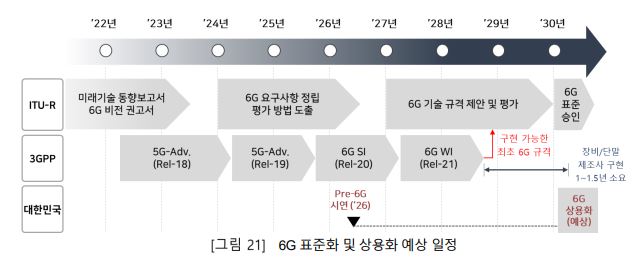SKT는 지난 10일 ‘6G 백서’를 발간해 6G 표준화를 위한 핵심 요구사항과 미래 네트워크 진화 방향성을 제시했다. SKT는 6G 신규 후보 주파수로 4-10GHz 대역을 검토하고 있다고 전했다. 우리나라는 28-30년을 목표로 26년 Pre-6G 시스템 기술을 시연하는 목표를 가지고 있다.
6G 후보 주파수 RF 기술·기지국 투자 가용성 제약 고려
ITU-R 6G 표준 제정 초기 논의…2030년 상용화
SKT가 6G 주파수로 기존 이동통신망에서 사용중인 저대역 및 중대역에서의 적극 활용을 주장했다.
SKT는 지난 10일 ‘6G 백서’를 발간해 6G 표준화를 위한 핵심 요구사항과 미래 네트워크 진화 방향성을 제시했다. 해당 백서에는 6G 시대의 주요 후보 주파수에 대한 논의 및 SKT의 발굴 현황이 소개됐다.
5G에서는 IMT 스펙트럼을 2개의 FR1, 2로 구분해 확장해 다양한 사용 시나리오를 충족해왔다. 각국의 주파수 정책과 연계돼 할당된 주파수 대역은 기존의 3G, LTE보다 확장된 서비스를 제공 가능하게 했다. 국내는 RF1에서 3.5GHz 대역을 할당 받고, FR2에서 28GHz 대역의 스펙트럼을 할당 받은 바 있다.
그러나 과기부는 지난해 KT, LG유플러스에 이어 지난 5월 SKT에 5G 28GHz 주파수 대역에 대해 할당취소를 최종 확정했다. SKT는 “시장 환경 조성이 미진해 수익화가 어려워 고주파대역 스펙트럼 사용이 활성화되지 못했다”고 전했다.
6G 후보 주파수로는 중대역(1~24GHz), 높은 고대역(24~92GHz), 서브 테라헤르츠 대역(92~300GHz) 등이 추가로 논의되고 있다. 또한 최근에는 용량과 커버리지를 모두 만족할 수 있는 어퍼 미드(Upper-mid) 대역(7~24Ghz)의 중요성이 주목받고 있다.
어퍼 미드 대역은 6G 후보 주파수 대역 중 기지국 커버리지와 용량을 균형적으로 확보 가능한 상위 중대역으로, 전파 특성이 상대적으로 낫다. 5G Sub-6 대역의 체감속도가 약 100Mbps, 최대속도 3.6Gbps에 비해 어퍼 미드 대역에서는 체감속도가 약 1Gbps, 최대속도는 200Gbps로 기대된다.
그러나 SKT는 “7GHz 이상의 상위 중대역에서 IMT 이외 위성, 초광대역(UWB), 북대서양 조약 기구(NATO) 등 타 서비스들이 여러 대역에 걸쳐 이미 존재하며, ITU-R에서 국제 무선 주파수 관리를 위해 구분한 3개 지역별 이해관계가 상이해 신규 IMT 대역의 발굴에 어려움이 있는 것도 사실”이라고 말했다.
또한 “5G 28GHz 주파수 대역 활성화 부진을 교훈 삼아, 높은 주파수 대역의 열악한 전파 특성을 보상하기 위한 RF 기술과 기지국의 투자 가용성의 제약을 고려해야 한다”며, “기존 이동통신망에서 사용중인 저대역 및 하위 중대역 활용을 적극 검토해야 한다”고 주장했다.
■ 3G·LTE 주파수, 5G로 활용한다
 ▲SKT 6G 백서 中
▲SKT 6G 백서 中
SKT는 6G 신규 후보 주파수로 4-10GHz 대역을 검토하고 있다고 전했다. 또한 "해당 대역은 효율적인 커버리지 구축과 기지국 용량 확보가 가능한 특성을 갖지만, 이미 여러 서비스들이 사용중인 상황이므로 기존 서비스와 공존 및 재배치 방안을 함께 연구하고 있다"고 말했다.
글로벌 주요 이통사들도 3G와 LTE 주파수를 5G로 활용하기 위한 기술 연구에 집중하고 있다. 동일대역 주파수 공유기술(Spectrum Sharing)을 활용해 중대역 및 밀리미터 대역과 CA, DC를 통해 5G 네트워크를 효율적으로 빠르게 구축해 나가고 있다.
SKT는 “6G 후보 주파수 대역 특징을 파악 및 초기 단계 요구사항 수립에 적극적인 선제적 연구를 진행해야 한다”고 덧붙였다.
한편 과기부가 지난 7월 제4이통사에게 28GHz 대역을 할당한다고 밝혔지만, 결국 비즈니스 모델과 더불어 수익성이 없는 고주파수 대역에 대한 대응이 미비할 경우, 기존 이통3사가 겪은 상황을 반복하게 될 것이라는 우려가 존재한다고 볼 수 있다.
제4이통사로 도전장을 내민 ‘미래모바일’은 지난 인터뷰에서 2.3GHz 대역으로 5G 전국망을 구축할 계획을 가지고 있다고 밝힌 바 있다. 28GHz와 함께 경쟁력 있는 전국 5G 서비스를 제공함으로써 수익을 창출하면 28GHz에 대한 투자를 이어 나가겠다는 목표다.
미래모바일 이경수 상임고문은 “시장 초기 진입 시에는 28GHz 주파수만으로 수익을 내기에는 어려움이 있다”며, “과거 와이브로 용으로 사용됐다가 현재 유휴 주파수 자원이 된 2.3GHz 주파수는 이통3사의 주파수 대역에 비해 주파수가 길어 투자비가 적게 들어 투자비 회수에 유리하다”고 말했다.
6G 후보 주파수 대역들은 2023년 11월에 개최되는 세계전파통신회의(WRC-23)에서 의제로 상정돼 2027년 세계전파통신회의(WRC-27)에서 확정될 것으로 전망된다.
현재 국제 표준화 기구 ITU-R에서는 차세대 이동통신 6G 표준 제정을 위한 초기 논의가 진행중이다. 이는 사실 표준화 기구 3GPP가 작성한 ITU-R에서 제시하는 IMT-2030 기술 성능 요구사항을 만족하는 6G 표준 규격을 기반으로 한다. 3GPP에서 실제 구현 가능한 규격이 완성된 후 장비 및 단말 제조사에서의 상용 제품이 개발되며, 최종적으로 2030년 정도 6G 상용화가 이루어질 것으로 예상된다.
우리나라도 24년부터 26년까지 약 3년 정도 성능, 기준, 평가 방법 등을 정의한다. 28-30년을 목표로 26년 Pre-6G 시스템 기술을 시연하는 목표를 가지고 있다.